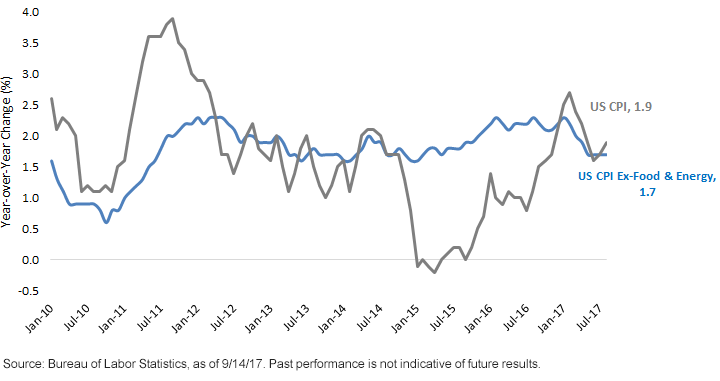Inflation: The Fed’s Mystery Machine


With last week’s Federal Open Market Committee (FOMC) meeting now in the rearview mirror, the money and bond markets are left trying to decipher what comes next. Typically, the central focus tends to be on the employment aspect of the Federal Reserve’s (Fed) dual mandate, but recent, and most likely future, attention has been placed more on the other goal: price stability. In Fed parlance, price stability means the inflation part of the equation. Despite the fact that monetary policy still remains accommodative (even with four rate hikes in this cycle and balance sheet normalization about to begin), and that the unemployment rate is only 4.4%, the inflation bogeyman has yet to rear its ugly head. This lack of price pressures has become the Fed’s Mystery Machine.
Interestingly, during Fed Chair Janet Yellen’s press conference, “mystery” was the word she used to describe inflation developments of late. The Fed is still holding to the premise that the factors that have helped to hold down price pressures are “transitory,” but the policymakers continue to emphasize that they are “monitoring inflation developments closely,” underscoring the point that the lack of inflation is vexing the Fed.
U.S. CPI vs. U.S. CPI ex-Food & Energy
Year-over-Year Change from 1/31/10 to 8/31/17

So, what exactly has been occurring on this front? After reaching near-term peak readings in February, the more closely watched inflation gauges have seen their year-over-year rate of increases continually trend lower in the subsequent months. With respect to the widely followed Consumer Price Index (CPI), the year-over-year gain dropped more than a full percentage point (pp) between February (+2.7%) and June (+1.6%). Over the last two months, the trend has shifted a bit with two straight modest monthly increases, leaving the new rate at +1.9% in August.
Needless to say, the Fed and economists have been trying to understand why inflation isn’t behaving as one would expect at this stage of an economic expansion. The one culprit that is commonly mentioned is the “one-off reduction” in wireless telephone services that Chair Yellen mentioned at the September FOMC presser. This is one of those transitory forces mentioned above and should go away as an influence in the months ahead.
In a recent public appearance, N.Y. Fed President William Dudley offered that perhaps some “more fundamental structural changes” could be playing a role. Here are some of these potential factors: “increased ability of prospective buyers to compare prices across different sellers quickly and easily, the shift in retail sales to online channels of distribution from traditional brick-and-mortar stores, and the consequences of these changes on brand loyalty and business pricing power.” Other causes that have been offered are: increased technology usage and the impact of cheaper goods being imported from emerging market nations such as China.
Within the domestic industrial sector, there is also spare capacity of noticeable proportions. According to the latest Fed data, the capacity utilization rate came in at 76.1%, or 3.8 pp below its long-run average. While there was some negative impact from Hurricane Harvey, this trend was in place before this storm’s adverse effect (the prior month’s reading was originally reported to be 3.2 pp under the long-run average).
Conclusion
The recent hurricanes could have a near-term impact of boosting gas and food prices, but these usually prove to be temporary and get reversed. Inflation expectations, which have fallen from their post-election high watermark, have stabilized of late but remain well below levels that existed earlier this year. Nevertheless, at this point, it does not appear to be affecting the Fed’s approach to monetary policy.
Unless otherwise noted, data source is the Bureau of Labor Statistics as of September 14, 2017.
Important Risks Related to this Article
Fixed income investments are subject to interest rate risk; their value will normally decline as interest rates rise. In addition, when interest rates fall, income may decline. Fixed income investments are also subject to credit risk, the risk that the issuer of a bond will fail to pay interest and principal in a timely manner or that negative perceptions of the issuer’s ability to make such payments will cause the price of that bond to decline.


